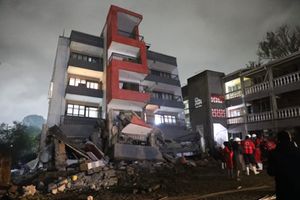Many counties no longer ‘rural’; don’t shortchange them on the housing pillar

President Uhuru Kenyatta (left) views the model of the houses to be constructed in Ngara under the affordable housing project. PHOTO | FILE | NATION MEDIA GROUP
What you need to know:
- Counties are encumbered with absolute lack of sanitation and waste disposal schemes, hence waterborne diseases and a heavy health bill.
- Without planned housing, waste emptying services essential link in sanitation, will be poorly managed, leading to faecal sludge dumping into water sources.
After a bevy of media-frenzied activities, all is quiet on the housing pillar of President Uhuru Kenyatta’s Big Four Agenda.
The last I heard a while back was when the President went to Nairobi’s Ngara Estate to inspect some ongoing construction.
His announcement that sourcing of building artisans and material would be local was laudable. The question is whether such a wish can be enforced, its guarantee and the incentives.
Meanwhile, there was a hasty promise that the Ngara houses would be ready by July and occupation in September. Well, September is here and all is quiet on that front too.
But the solitude in the National Housing Development Fund (NHDF) saga is most pronounced in the counties.
The controversy of the imposed levy notwithstanding, counties were co-opted into the NHDF by way of being goaded to provide land while the national government would acquire the investors to build houses for onward sale.
Counties saw in this an investment worth undertaking for both their income generation and solving dire housing shortage.
GROWTH
Many counties invested in land harvesting, but that could now be dead capital given the prevailing silence.
Most galling is suspicion that national government has quietly recalled the promissory note it gave counties and would rather concentrate on delivering “some” houses just in Nairobi.
That would be betrayal befitting a King’s ransom. For though most attention on housing deficit is focused mainly in the metropolis like Nairobi, the dearth of housing is acute in hitherto rural counties.
While Nairobi may be in need of “affordable” housing, counties are in dire need of “liveable” housing.
Fact is, a sizable number of counties are no longer “rural” but have graduated into peri-urban or “rural slum” status.
Where hitherto economic mainstay of such counties was peasant agriculture, population increase has decreased acreage available to farming.
CONGESTION
Further subdivision to create space for housing of family members has had the effect of forcing residents to ditch peasant agriculture and now buy food in no lesser fashion than their urban poor in Nairobi.
Congestion on small pieces of land is now a given. It is no longer strange for fights to erupt over mundane infringements like house eaves overlapping.
This has menacingly augmented the problem of poor sanitation and lack of waste disposal; flying toilets are quickly replacing pit toilets. This is evident in most market places that to a keen eye appear like cattle sheds.
The recent exposé by the Daily Nation on the sewage menace in the Athi River is child’s play compared to the filth imbibed as water from springs flows in counties.
People are dying in droves in counties as a result of preventable waterborne diseases.
DISEASES
Increase in drop toilets and users have had the venomous effect of contaminating water tables uphill so that what is drained downhill from springs is mainly thin human waste.
Indeed, the preponderance of the heavy health bill in counties is proportional to the prevalence of preventable waterborne diseases.
It is no secret that non-availability of basic drugs in county health facilities turns into a disaster to be managed, most of the time, under strained emergency procedures.
There is therefore a whole chunk of county residents who desire and need modern “liveable” housing.
In addition, with the onset of devolution and influx of workers in reverse urban-to-rural migration, counties are at pains to provide “cheap” housing of any kind.
It is this reality that made counties readily buy into the housing pillar and spend scarce resources acquiring land ready for investment.
PHYSICAL PLANNING
To be let down at this stage will spell disaster for counties overwhelmed by lack of spatial planning.
The worst legacy of the defunct local authorities is their having presided over a dysfunctional physical planning system or lack of it.
Counties are encumbered with absolute lack of sanitation and waste disposal schemes, hence waterborne diseases and a heavy health bill.
Why am I connecting dots between seemingly dissimilar things — housing, spatial planning, sanitation, and human waste disposal?
I’m not alone in worrying about the deleterious impacts of unplanned waste disposal that comes with lack of physical planning for housing.
During the recent World Water Week in Stockholm, Sweden, it was revealed that on average, less than a third of the millions of tonnes of faecal sludge produced per day in Africa is discharged into treatment plants. Where does the rest go?
Participants agreed that human waste disposal is an urgent problem because 95 per cent of waste water in Africa is not treated.
WASTE DISPOSAL
Therefore, water quality cannot be achieved without the proper management of faecal sludge.
Without planned housing, waste emptying services essential link in sanitation, will be poorly managed, leading to faecal sludge dumping into water sources.
The ongoing World Bank-sponsored urban renewal programme being implemented in counties and a “planned” housing intervention will add vitality to the viability of this project.
This facility will run to waste if the housing component is not integrated under spatial planning.
Mr Kabatesi is a communication and political consultant




